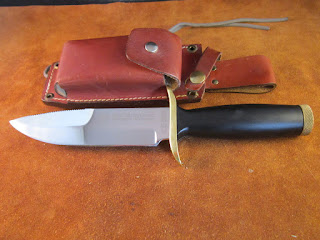1950's Cold War Nuclear Bomber Survival Knife!

Over half a century ago the United States Air Force was America's primary nuclear deterrent. This was accomplished by its long range bomber aircraft operated by the Strategic Air Command, the B-36, the B-47 and later on the B-52. ICBMs came along even later. To maintain razor sharp proficiency in the nuclear mission long range training missions were an daily occurrence and took airmen over every corner of the world. The Air Force became interested in refining its survival kits and equipment, particularly for arctic and alpine regions, as the fastest way to the targets in the Soviet Union was often over the polar route. Training missions sometimes turned into real life survival events. In the late 1940's, General Curtis LeMay, the head of the Strategic Air Command (SAC), authorized the creation of a survival kit for the crews of the long range bombers. Requirements were to be an effective tool for survival in the wild, with the ability to perform a number of functions to inclu...







